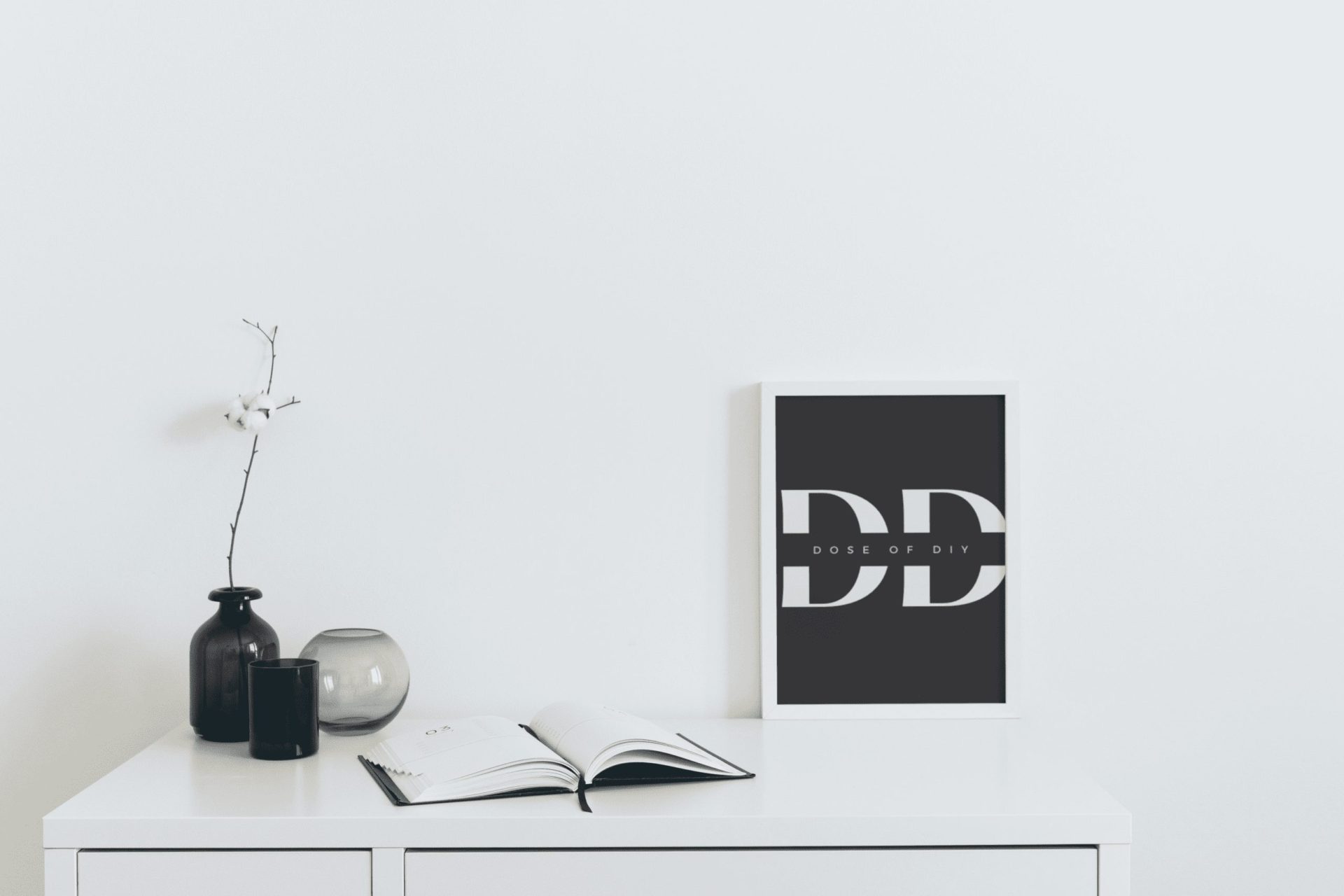I’m going to walk you through how to make your own DIY entryway shoe storage cabinet for the perfect hidden shoe storage to avoid having a cluttered entryway!
As an Amazon Associate I may earn from qualifying purchases at no additional cost to you!
Materials
- Ekena Millwork fluted panel moulding – for fluted look on cabinet doors; the quantity depends on the size of your cabinet
- Rubbermaid white shelf 10″ x 72″ – how many depends on the amount of shelves you want
- Rubbermaid white shelf 10″ x 48″ x 2 for the sides of the cabinet
- 1/4″ plywood 4′ x 8′ x 1 for the cabinet doors
- 1 in. x 4 in. x 8 ft. MDF molding – for the outer frame on the cabinet doors; the quantity depends on the size of your cabinet
- Alex painters acrylic latex caulk
- cabinet door hinges
- BEHR MARQUEE #PPU18-01 Cracked Pepper semi-gloss paint
- Kreg pocket hole screws
- wood filler
- universal primer
Paint Supplies
- Paint brush or pro-grade paint brushes
- Painter’s drop cloth or plastic adhesive drop film
- Portable medium spray shelter
- Paint sprayer
- Frog tape or painter’s tape
- Miracle wipes for paint cleanup
- Foam paint roller kit or microfiber paint roller
- Paint tray or Amazon paint roller kit
Optional:
Tools
Either
- pneumatic brad nailer
- air compressor – you don’t need this if you have a cordless nailer
- 1/4″ NPT air compressor tool kit with hose and accessories – you don’t need this if you have a cordless nailer
or
Steps
First, I recommend checking out my video on YouTube since I am not the best at describing things. Be sure to subscribe to my YouTube channel!
Otherwise, I’ve broken down the process into 3 basic steps. You can click on the step below to jump to that section, or just keep scrolling along!
For reference, this is how I was storing my shoes when I first moved into my condo…

These shoe racks worked for me while I was moving from apartment to apartment, but now that I bought my very first home, I wanted to hide my shoes so everyone that came didn’t have to look at them.
1. Make Shoe Storage Cabinet Frame
First, determine the size that you want your shoe storage cabinet to be & cut the Rubbermaid shelves to be that length.
To start, measure the area you want the shoe storage cabinet to go. Based on the measurements of the area I wanted my shoe storage cabinet to go, I decided I wanted mine to be about 60″ wide x 41.75″ tall. Therefore, the amount of the Rubbermaid shelves you will need depends on the amount of shelves you want your shoe storage cabinet to have.

Shoe Storage Cabinet Width
- First, I knew that I wanted 5 shelves because I have A LOT of shoes. So I cut 5 of the 72″ boards to be 60″ wide. These boards would go between the 2 vertical boards
- Then, for the shelf that was going to be on top, I wanted it to be on top of the 2 vertical sides, instead of in between them. Therefore, I know that one board needed to be slightly longer than the other 5 shelves. In order to figure out that board’s length, I had to add the width of the vertical boards, which were both 3/4 in. thick. With both sides, I had to add 1.5 in. to the length of this top board. Therefore, I cut the top board to be 61.5″ long

Shoe Storage Cabinet Height
- First, I measured the heights of my taller shoes (i.e., boots) and decided I wanted to have one shelf that was 10″ tall for those taller shoes.
- Then, for the rest of the shelves, I wanted to be about 7″ tall.
- Additionally, I also had to take into account the height of the shelves, which is about 3/4 in. Since there are 5 of them, I needed to add 3.75″ to the height of shoe storage cabinet.
- Therefore, I cut 2 of the 48″ boards to be 41.75″ tall.

Add shelf pin holes to the vertical boards
- I used a Kreg Shelf Pin Drilling Jig to put holes in the boards where I would put the shelf pins that would hold the shelves.

Put together the shoe storage cabinet frame with a Kreg pocket hole jig
First, see this YouTube video I made about how to use a Kreg pocket hole jig or watch me do it in my YouTube video about how I made this shoe storage cabinet.

Now you want to set up the boards of the outer framework of the shoe cabinet at 90 degree angles.

I used a Kreg Automaxx Right Angle Clamp to try to connect the boards at a right angle. But to be completely honest, I didn’t find it to be that helpful (maybe just user error?). I found it difficult to get it to clamp it tight enough to hold the boards tightly at a 90 degree angle, but maybe you will have better luck than I did.

Cassie Tip:
- Make sure to use the right screw length for the board you are working with. For example, when I used the Kreg 1.25″ Pocket Screws, it went through the board and you could see the tip of the screw on the other side. Then, I realized Kreg makes Kreg 1″ Pocket Screws.
Place shelves into the shoe cabinet framework
- Insert the shelf pins into the framework.

- Place the shelves into the framework.

And now it’s time to make the doors for this bad boy!
2. Make Shoe Storage Cabinet Doors
- First, cut the plywood to be the size of the shoe storage cabinet (41.75″ x 61.5″)
- See my YouTube video to learn how to saw a straight line for beginners (and if you don’t have a dangerous table saw)
- Then, cut that in half to be the two cabinet doors

- Then, cut the 1″ x 4″ MDF molding to be the framing on the shoe storage cabinet door

- If you like the design I used on my cabinet door, here is a schematic of the pieces you will need to cut.

- Afterwards, attach the different parts of the door framing together with a kreg pocket hole jig. Again, see my YouTube video about how to use a Kreg pocket hole jig if you haven’t done it before!

- I used a Kreg face clamp to make sure I wasn’t screwing it together crooked.

- Before I attached the door framework onto the plywood, I wanted to prep the plywood.
- Therefore, I sanded and primed the plywood.

- After that dried, I painted it to be the color I wanted the doors to be. I am not sure this is required, but I was worried that if there were any gaps in my framework or the fluted moulding, that the wood or white would show through.

- Then, use a nail gun to attach the plywood to shoe storage cabinet door outer frame
Cassie Tip:
- Similar to making sure your kreg pocket hole screws were the right size, you want to make sure your brad nails are the right size so that they aren’t poking out of the other side of the shoe cabinet door!



- Then, I attached the middle pieces of the framework to the plywood with construction adhesive.

- Then, cut the Ekena Millwork fluted panel moulding to be the height between the squares of the cabinet door frame

- Again, if you like the design I did, here is the schematic of how you will need to cut the Ekena Millwork fluted panel moulding (orange rectangles).

- Afterwards, I attached the Ekena Millwork fluted panel moulding pieces to the door with construction adhesive

- Then, to hide the gaps between the pieces of Ekena Millwork fluted panel moulding, I filled in the gaps with caulk
Cassie Tip:
- I recommend using Alex painters acrylic latex caulk because I had used other caulks and they kept shrinking, so I had to keep going in and filling in the gaps more and more. Since this caulk is made for painting, it is less likely to shrink!

- Finally, I added primer to the entire door and then painted it with the BEHR MARQUEE Cracked Pepper Semi-Gloss paint

- In order to get between the fluted moulding, I had to go in with a brush.

3. Add Doors to the Frame
Finally, it’s time to attach the doors to the shoe storage cabinet frame. How you attach them depends on the hinges that you use, so you should follow the directions for your hinges. I wanted overlay hinges, which is where the cabinet doors are covering the frame of the cabinet.

Be sure to comment to let me know your thoughts or if you have any questions! And please share any pictures if you recreated this in your home!
And don’t forget to check out my entertainment suggestions if you get bored!
Additionally, if you need shoe storage, but don’t want to try my idea, check out my Shoe Storage Pinterest board for some inspiration!






Leave a Reply